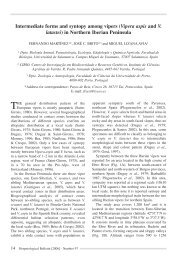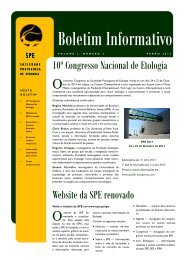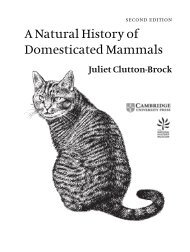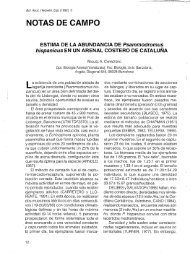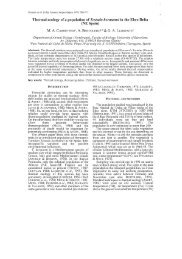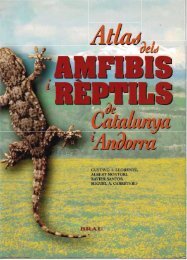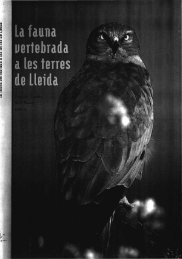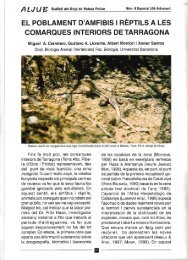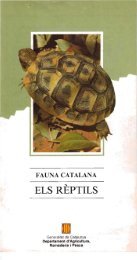6th Ordinary General Meeting Societas Europaea Herpetologica
6th Ordinary General Meeting Societas Europaea Herpetologica
6th Ordinary General Meeting Societas Europaea Herpetologica
Create successful ePaper yourself
Turn your PDF publications into a flip-book with our unique Google optimized e-Paper software.
of<br />
6 th <strong>Ordinary</strong> <strong>General</strong> <strong>Meeting</strong><br />
of<br />
<strong>Societas</strong> <strong>Europaea</strong> <strong>Herpetologica</strong><br />
19-23 August 1991<br />
Budapest,<br />
the<br />
the<br />
Hungary<br />
edited<br />
by<br />
• Z. Korsos & I. Kiss<br />
Hungarian Natural History Museum<br />
Budapest<br />
1992
Korsos, z.-&Kis&, 1. (eds) (1992)<br />
Proc. Sixth Ord. Gen. Meet. S. R H, Budapest 1991,pp.l07·113.<br />
Reintroduction of Psammodromus hispanicus in a<br />
coastal sand area of NE Spain<br />
Psammodromus hispanicus is a smalliacertid lizard which ranges all the Iberian<br />
Peninsula, excepting the north and the Pyrenean Mountains (BARBADIUO 1987)<br />
and the SE of France (FRETEY 1987). It is nominally protected by Spanish law<br />
(BoletIn Oficial del Estado 56: 4999-5002, 6. 3. 1981). Recent studies have analyzed<br />
its ecological trends and natural history (PASCUAL& PEREZ-MELlADO 1987,<br />
1989, POLLO& PEREZ-MELLADO1988, 1989, 1990, CARRETERO& LLORENTE,in<br />
press). It occurs mainly in the Mediterranean garigue or in more open areas,<br />
around patchy dense vegetation (ARNOLD 1987, CARRASCALet al. 1989). It is<br />
common to see animals moving quickly from one plant (20-30 cm high) to another.<br />
In the NE of the Iberian Peninsula, the most dense populations are located in<br />
the coast, particularly in sandy areas. The development of the <strong>Herpetologica</strong>l Atlas<br />
of Catalonia (unpublished data) and Languedoc-Rousillon (GENIEZ & CHEYlAN<br />
1987) have allowed us to prove that the range of distribution of this species is not<br />
continuous. At the present, French and Spanish populations are not connected<br />
(Fig. 1) but they were probably a continuum in the recent past (FELIX pers. com.).<br />
The northernmost Spanish population is located in Pals Beach (UTM 31TEG25)<br />
where P. hispanicus and its congeneric species P. algirus live together. The southernmost<br />
French records are close to the Spanish frontier.<br />
The intermediate zone (Alt Emporda region) has some favourable sites to be<br />
occupied, such as the coastal dunes between Muga and Fluvia rivers (Fig. 2). P.<br />
algirus is present there and has been previously studied (CARRETERO& LLORENTE<br />
1989). The psammophilous vegetation (Theucrium, Echinophora, Ammophila, Pancratium)<br />
and the habitat structure are quite similar to other coastal locations of the<br />
Spanish Psammodromus. Indeed, a record near that site was published at the<br />
beginning of this century (MALUQUER1916).<br />
The above facts have induced us to believe that the species has become extinct<br />
recently. Probably the tourist industry (destruction of psammophilous vegetation<br />
near beaches) is responsible. Now, this zone belongs to the Pare Natural dels<br />
Aiguamolls de l'Emporda created in 1985 and it receives complete protection.<br />
Since the creation of the park, the possibility of reintroducing the species has<br />
been planned with two consecutive objectives:<br />
1. - Management: re-creation of a stable population of Psammodromus hispanicus.<br />
2. - Ecology: employment of this reintroduction as a tool to know how both<br />
Psammodromus species use the same ecological resources.
Only the first point is being carried out and it is reported here. The next step<br />
was to decide when and where to obtain the animals.<br />
The reproduction of the species has been previously studied in the NE of Spain<br />
(CARRETERO& LLORENTEin press). This lizard has a one-year cycle (Fig. 3).<br />
Young are born from July to September. They grow up very fast, becoming adults<br />
during the next spring. There is no winter diapause period. The life is very short.<br />
Only 5% of the adult lizards can breed in the second year. Two clutches have been<br />
detected in large females and they are reflected in the ovarian cycle (Fig. 4).<br />
In order to maximize the number of initial individuals it was important to use<br />
adults during the reproductive period. Particularly, it was interesting that females<br />
were able to lay two clutches in the introduction area. The best moment for doing<br />
that was in April-May,· since females already carry the eggs of the first clutch<br />
(Fig. 4).<br />
The best places to capture animals are the abundant populations (20 individuals/ha)<br />
in the Llobregat Delta near Barcelona, which have been observed for a<br />
long time.<br />
Thirty adult specimens (19 males and 11 females) were captured in a locality<br />
near Barcelona (Gava beach UTM 31TDF16) on 4th May, 1990. Seven females had<br />
oviductal eggs and 3 had copulation marks. Snout-vent length (mm) and weight (g)<br />
Fig. 1. Distribution of Psammodromlls hispanic/IS in C-atalonia, NE Spain (unpublished data<br />
from the <strong>Herpetologica</strong>l Atlas of Catalonia). The arrow marks the reintroduction area
were measured and the specimens were marked individually by toe clipping. The<br />
lizards were released the next day in an open area close to Muga river (UTM<br />
squares 31TEG1075, 0915 and 0974).<br />
The zone was visited 10 times since the introduction. Two to four observers<br />
registered actively the plants and bushes during 3 hours at the period of maximum<br />
activity looking for active animals. Captured animals were measured, and marked<br />
if new captures. Observed lizards were also noted.<br />
Most of the introduced animals disappeared after three months of observations.<br />
Their growth was slow (about 0.04 mm/day).<br />
Young lizards were not observed until September when some of them had<br />
reached the minimum adult size (see PASCUAL& PEREZ-MELLADO1989, CAR-<br />
RETERO & LLORENTE, in press). As a consequence, the growing rates of the<br />
juveniles were higher than those of the adults. The SVL of the hatchlings is about<br />
23-25 mm (see the same references). If we assume the 15th July as hatching date (a<br />
conservative estimation). it results in 0.16 mm/day approximately (Fig. 6).<br />
N<br />
t eo
A total of 24 unmarked individuals (17 males and 6 females) were observed.<br />
Only one introduced animal survived to the next spring. During this season gravid<br />
females and males with sexual colouration were detected among the new individuals.<br />
Clutches were detected in two females.<br />
On the other hand, the total number of Psammodromus algirus, the other<br />
sympatric species, decreased gradually towards summer. Most of them were immature<br />
individuals.<br />
Looking at the results, it can be concluded that the introduced animals bred<br />
successfully in that season in the study area.<br />
The chronology of the species is very similar to that in other Mediterranean<br />
localities. P. hispanicus tends to. a r-strategy and the new cohort replaces quickly<br />
the old one every year. This feature allows this lizard to be the first colonizer of<br />
new areas inside its distribution range (SANTOS& TELLERIA1988). However, it<br />
also produces great variations in population size (PASCUAL& PEREZ-MELLADO<br />
1989) depending on the conditions of the year (climate and fOOd).<br />
The decrease of P. algirus must be interpreted as the natural mortality of<br />
juveniles. Only some of them (about 10%) will become adults. Habitat competition<br />
1<br />
...-,_..~--.------<br />
//.-- .----'. ---~-<br />
/';>/<br />
~;;/<br />
(I<br />
.. /.,.~.... ~<br />
~Bl.n:.TS<br />
Fig. 3. Annual variation of gonads and fat bodies in males and females. The arrow marks the<br />
best moment for the reintroduction (see text)
with its congeneric species plays probably a negligible role (CARRASCAL et a1.<br />
1989).<br />
The future of the introduced population is still uncertain. Despite its reproductive<br />
potencial, the perspectives depend not only on the abundance of the next<br />
generation but also on the conservation of habitat structure (HONEGGER 1981).<br />
GONADS ;\ND Ft,T BOD!ES VARIATIONS<br />
(umlTHLY AVERAGES)<br />
- .... .......------ -. ···-1<br />
'.<br />
.,'<br />
-~-r--~<br />
••<br />
F u A Uy In Jy A S 0 N 0<br />
Fig. 4. Reproductive cycle of Psammodromlls hispaniclIs in NE Spain (from CARREfERO &<br />
LLORENTE in press)
50<br />
45<br />
0<br />
• o.<br />
•<br />
0•<br />
• • • DO 0<br />
I<br />
40 0 0<br />
.......<br />
E<br />
!.35<br />
0 0<br />
• 0<br />
0 0 0 0<br />
•<br />
0 0 0<br />
0 0 0<br />
0 0 0<br />
• 0 0<br />
0<br />
0<br />
-J<br />
><br />
V1 30<br />
0<br />
25 0<br />
?<br />
20<br />
-100 0 100 200 300 400 500<br />
! ! DAYS<br />
reintr oduction first hatchlings ?<br />
I • 1 ST GENERATION 0 2 NO GENERA TION<br />
Fig. 5. Sizes of the animals found in the periodic visits. Two generations<br />
(explanation in text)<br />
are represented<br />
Acknowledgements - The Pare Natural dels Aiguamolls de l'Empordfi supplied all the<br />
facilities for research in the study area. SERGI,EVARISTO,NURIA,FABIAN,ORIOL,JOSELUIS<br />
and JOSEhelped actively in the field work. Thank you very much!<br />
ARNOLD, E. N. (1987): Resource partition among lacertid lizards in southern Europe. - J.<br />
Zool. Lond. (B) 1: 739-782.<br />
BARBADILLO, L. J. (1987): La gufa de Incafo de los Anfibios y Reptiles de la Penfnsula<br />
Iberica, Islas Baleares y Canarias. - INCAFO, Madrid, pp. 694.<br />
CARRASCAL, L. M., DIAZ, J. A. & CANO, C. (1989): Habitat selection in Iberian Psammodromus<br />
species along a Mediterranean successional gradient. - Amphibia-Reptilia 10:<br />
231-242.<br />
CARRETERO, M. A. & LLORENTE, G. A (in press): Reproducci6n de Psammodromus<br />
hispanicus en un arena Icostero del nordeste iberica. -Amphibia-Reptilia<br />
FRETEY, J. (1987): Guide des Reptiles de France. - Hatier, pp. 255.
GENIEZ, P. & CHEYLAN, M. (1987): Atlas de distribution des Reptiles at Amphibiens du<br />
Languedoc-Roussillon. - In: GRIVE et Lab. Biog. Eco!. Vertebres, EPHE (eds.), Montpellier,<br />
pp. 113.<br />
HONEGGER, R. E. (1981): Threatened Amphibians and Reptiles in Europe. European Committee<br />
for the Conservation of Nature and Natural Resources. - Council of Europe,<br />
Akademische VerlagsgeseUschaft, Wiesbaden, pp. 158.<br />
MALUQUER, J. (1916): Nota Herpetol6gica. -BulL Inst. Cat. Hut. Nat. 16(1): 11-14.<br />
PASCUAL,J. A & PEREZ-MElLADO, V. (1987): Alimentaci6n de Psammodromus bispanicus<br />
Fitzinger, 1826 (Sauria, Lacertidae) en un medio adehesado del Centro Oeste de la<br />
Penfnsula Ibtrica. -Rev. Esp. Herp. Z: 165-182.<br />
PASCUAL,J. A & PEREZ-ME1LADO, V. (1989): Datos sabre la reproducci6n y el crecimiento<br />
de Psammodromus hispanicus Fitzinger, 1826 en un medio adehesado de la Espafta<br />
central Doftana -Acta Vertebrata 16(1): 45-55.<br />
POlLO, C. J. & PEREZ-MELLADO, V. (1988): Trophic ecology of a taxocenosis of mediterranean<br />
Lacertidae. - Ecologia Medite"anea 14(3/4).<br />
POlLO, C. J. & PEREZ-MELLADO, V. (1989): Activity and thermoregulation on three mediterranean<br />
species of Lacertidae. - Herp. 1. 1: 343-350.<br />
POLLO, C. J. & PEREZ-MELLADO, V. (1990): Biologfa reproductora de tres especies meditem1neas<br />
de Lacertidae. - Meditemjnea Ser. Bioi. 12: 149-160.<br />
SANTOS,T. & TELLERIA, J. L. (1988): Preferencias de habitat y perspectivas de conservaci6n<br />
en una comunidad de lacertidos en medios cerealistas del centro de Espana. - Rev. Esp.<br />
Herp. 3(2): 259-272.<br />
Miguel A. Carretero<br />
Departament de Biologia Animal<br />
(Vertebrats), Facultat de Biologia,<br />
Universitat de Barcelona<br />
Avgda. Diagonal 645,<br />
E-08028 Barcelona<br />
Spain



